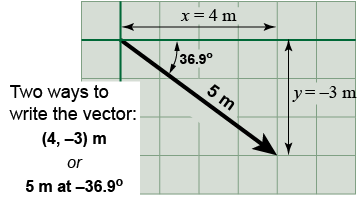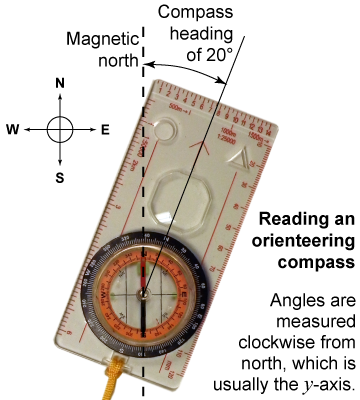|

| Describing a vector as 5 m at an angle of 36.9° is one way of expressing both magnitude and direction. This is called a polar vector because it uses the resolution of components in which every point is specified with a radius (magnitude) and angle. To follow convention, the 5 m displacement (illustrated at right) is given an angle of −36.9°, because angles increase from 0° on the x-axis to 90° on the y-axis. Clockwise angles are negative and counterclockwise angles are positive. |

|

|
Vectors can be written in more than one way using different coordinate systems. The most common representation is using Cartesian coordinates, which uses the vector components along the x-, y-, and possibly z-axes, such as = (+4,−3) m. The coordinate system that uses polar vectors is called polar coordinates. The vector can also be represented by using a vector diagram. The 5 m displacement of our example is shown above in a vector diagram, as well as using polar and Cartesian coordinates. 
 |
A laser cutting machine—used in manufacturing to cut parts from sheet metal—uses Cartesian coordinates to represent the position of the laser. An engineer will design the part and specify the movements of the laser in (x, y, z) coordinates. As shown in the video, when the machine is in operation, a display monitor shows the current position of the laser as it makes its cuts. While the positions on the metal sheet itself are only in two dimensions (x, y), the laser's vertical position is given by the third or z-coordinate. 
|
 Most navigation is done using compass coordinates. A compass divides direction into 360°—a full circle. Compass coordinates are rotated from standard geometry coordinates because they use north instead of east as a reference. (In mathematics class you will usually measure angles starting from the horizontal direction, rather than the vertical direction!)
Most navigation is done using compass coordinates. A compass divides direction into 360°—a full circle. Compass coordinates are rotated from standard geometry coordinates because they use north instead of east as a reference. (In mathematics class you will usually measure angles starting from the horizontal direction, rather than the vertical direction!)
In compass coordinates - angles increase in the clockwise direction (starting from north) and
- 0° is north, which is usually the y-axis in a two-dimensional system.

|
A compass heading of 20° is 20° clockwise from north. This is the same as a heading of +70° from the x-axis. Compass headings range from 0–360°; a compass heading of 210° is 210° clockwise from north, for example. You should always draw a vector diagram that puts the vector in the right quadrant to figure out components from compass angles. 
|
A displacement vector is = (+7,−3) m. Express this vector in polar coordinates.
 |
Note that the y-coordinate is negative, which means that the position angle in polar coordinates will be negative.
The magnitude (or radius) of the polar vector is given by the Pythagorean theorem, equation (6.3): The position angle is given by equation (6.4): 
|

